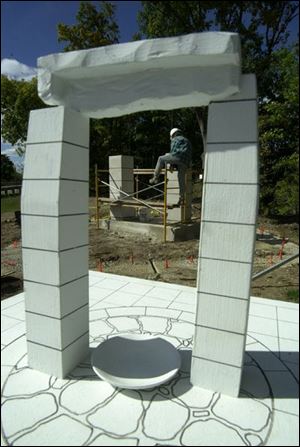
Monument recalls Irish potato famine
10/6/2003
Sculpture technician Mike Barker is framed by a model of the memorial. The local chapter of the Ancient Order of the Hibernians initiated the $40,000 project.
ONSTED, Mich. - When Patrick Maguire first came to Ken Thompson, he wondered if the artist could create a sculpture, here in the Irish Hills, to memorialize the lives lost during Ireland's great potato famine.
“Ken's words to me were, `Surely you don't want to do a typical Celtic cross,'” said Mr. Maguire, laughing as he recalled the initial conversation.
About two years later, and after bringing a number of ideas to the Blissfield artist, Mr. Maguire finally struck a pot of gold. He got a stone step from Cork Harbor, Ireland - one of the last steps that fleeing Irish immigrants would tread upon before boarding a ship bound for the New World.
“Ken responded, `Now we finally have something we can work with,'” Mr. Maguire said.
That step, from the Penrose Quay in Cork Harbor, became the focal point of an archlike sculpture now standing to the west of St. Joseph's Shrine in Lenawee County's Irish Hills.
Secured atop two 10-foot limestone columns, the lintel is just high enough to command respect from those below. Between the pillars is an empty bronze bowl to signify famine and hunger. Encircling the structure are 32 slate pavers bearing the names - in English and Gaelic - of the counties of Ireland.
Put together, the pieces create a structure filled with symbolism that promotes awareness and understanding of the famine that struck Ireland in 1845 and lasted six years.
“We want to make sure that our people who died in the Great Famine are not forgotten,” Mr. Maguire said. “We want people to know how the people suffered during that time.”
By the middle of the 19th century, many Irish - mostly Catholic - were living in poverty and relying almost entirely on potatoes for survival. When the potato blight first struck, it destroyed the crop and plunged millions into starvation.
An estimated 2 million died of starvation and disease, and immigration to America, Canada, and Australia was greatly accelerated.
“You wouldn't have the Irish in this country if it weren't for the potato famine,” Mr. Thompson said. “This generation decided to do something about that.”
The $40,000 project was initiated by the local chapter of the Ancient Order of the Hibernians. Created centuries ago in Ireland to protect Catholic priests and nuns from British persecution, the Hibernians have morphed into a men's organization aiming to protect and remember Irish history. In Michigan, there are 13 such groups. The Adrian chapter has 45 members.
Mr. Maguire, a native of Ireland who lives in Adrian, is president of the Michigan chapter of the Hibernians. He said chapters nationwide had been urged by the national organization to erect memorials of the famine.
To date, memorials can be found in cities from Boston to Los Angeles, he said. The large arch in northern Lenawee County would be the first in Michigan.
Mary Ouellette, also a native of Ireland, stopped by the construction site last week to eye the progress. She admitted she was wary of the design at first but was pleased as she watched it come together.
She said her hopes for the sculpture were twofold: to remember those who died during the famine and to celebrate those who eventually made the hilly area of northern Lenawee County their home.
“It's a part of our heritage,” said Mrs. Ouellette, who emigrated from Galway, Ireland, in 1952. “I think for us, the legacy, if there is a legacy, of the famine would be the fact that the Irish immigrants came here to the Irish Hills and settled because it reminded them of Ireland.”
The monument, which will include a bronze plaque listing donors, plus cobblestones from Ireland, will not be completed until the spring when a 144-foot stone wall is built behind it. Reminiscent of the handmade walls seen on farms in Ireland, the wall is the final piece of the sculpture, Mr. Thompson said.
The artist, whose work can be seen in Toledo's Civic Center mall, said he was pleased to be a part of the project.